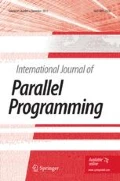Abstract
A new, parallel approach for generating Bresenham-type lines is developed. Coordinate pairs which approximate straight lines on a square grid are derived from line equations. These pairs serve as a basis for the development of four new parallel algorithms. One of the algorithms uses the fact that straight time generation is equivalent to a vector prefix sums calculation. The algorithms execute on a binary tree of processors. Each node in the tree performs a simple calculation that involves only additions and shifts. All four algorithms have time complexityO(log2 n) wheren in the form 2m denotes the number of points generated andn-1 is the number of processors in the tree. This compares toO(n) for Bresenham's algorithm executed on a sequential processor. Pipelining can be used to achieve a constant time per line generation as long as line length is less thann.
Similar content being viewed by others
References
J. E. Hbresenham, Algorithm for Computer Control of a Digital Plotter,IBM Systems Journal,4(4):25–30 (1965).
J. D. Foley and A. Van Dam,Fundamentals of Interactive Computer Graphics, Addison-Wesley, pp. 433–436 (1982).
R. Brons, Theoretical and Linguistic Methods for Describing Straight Lines,Fundamental Algorithms for Computer Graphics, (ed.), R. A. Earnshaw, NATO ASI Series F, Volume 17, Springer-Verlag, pp. 19–57 (1985).
R. F. Sproull, Using Program Transformations to Derive Line-Drawing Algorithms,ACM Transactions on Graphics,1(4):259–273 (October 1982).
W. E. Wright, Parallelization of Bresenham's Line and Circle Algorithms,IEEE Computer Graphics and Applications,10(9):60–67 (September 1990).
H. Fuchs, An Introduction to Pixed-Planes and other VLSI-intensive Graphics Systems,Theoretical Foundations of Computer Graphics and CAD, (ed.), R. A. Earnshaw, NATO ASI Series F, Volume 40, Springer-Verlag, pp. 675–688 (1988).
G. E. Blelloch, Scans as Primitive Parallel Operations,IEEE Transactions on Computers,38(11):1526–1538 (November 1989).
J. Van Aken and M. Novak, Curve-Drawing Algorithms for Raster Displays,ACM Transactions on Graphics,4(2):147–169 (April 1985).
J. E. Bresenham, Ambiguities is Incremental Line Rastering,IEEE Computer Graphics and Applications,7(5):31–43 (May 1987).
R. E. Ladner and M. J. Fischer, Farallel Prefix Computation,J. ACM,27(4):831–838 (October 1980).
H. Meijer and S. Akl, Optimal Computation of Prrfix Sums on a Binary Tree of Processors,Int'l. JPP,16(2):127–136 (1987).
R. Cole and U. Vishkin, Faster Optimal Parallel Prefix Sums and List Ranking,Information and Control,81(3):334–352 (June 1989).
Author information
Authors and Affiliations
Rights and permissions
About this article
Cite this article
Sosič, R., Riesenfeld, R.F. Parallel algorithms for line generation. Int J Parallel Prog 19, 389–404 (1990). https://doi.org/10.1007/BF01407907
Received:
Revised:
Issue Date:
DOI: https://doi.org/10.1007/BF01407907




